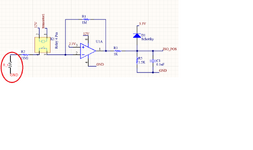matrino
Newbie level 4

Hi,
I'm encountering an issue with a circuit (which I've attached to this post). In this circuit, I'm trying to measure the resistance of the component indicated by the red circle. However, I'm facing a problem. I'm using an STM32G030F6P microcontroller to measure the voltage at the node labeled IZO_POS using an ADC pin.
When the resistance is under 100 kohms, the deviation of the measured resistor value increases, which isn't acceptable for this project. For instance, when I use a 10 kohm resistor, I typically read values between 15-20 kohms.
When the resistance is over 100 kohms, I observe a 20% error, which tends to underestimate the real value.
Can you suggest a solution to this problem? Your assistance would be greatly appreciated.
Also, just to provide more context, the 2.5 volts come from a TL431, and the op-amp being used is an LM358 in surface mount device (SMD) form.
Additionally, this circuit will be used to track insulation leakage in electic car.
I'm encountering an issue with a circuit (which I've attached to this post). In this circuit, I'm trying to measure the resistance of the component indicated by the red circle. However, I'm facing a problem. I'm using an STM32G030F6P microcontroller to measure the voltage at the node labeled IZO_POS using an ADC pin.
When the resistance is under 100 kohms, the deviation of the measured resistor value increases, which isn't acceptable for this project. For instance, when I use a 10 kohm resistor, I typically read values between 15-20 kohms.
When the resistance is over 100 kohms, I observe a 20% error, which tends to underestimate the real value.
Can you suggest a solution to this problem? Your assistance would be greatly appreciated.
Also, just to provide more context, the 2.5 volts come from a TL431, and the op-amp being used is an LM358 in surface mount device (SMD) form.
Additionally, this circuit will be used to track insulation leakage in electic car.

